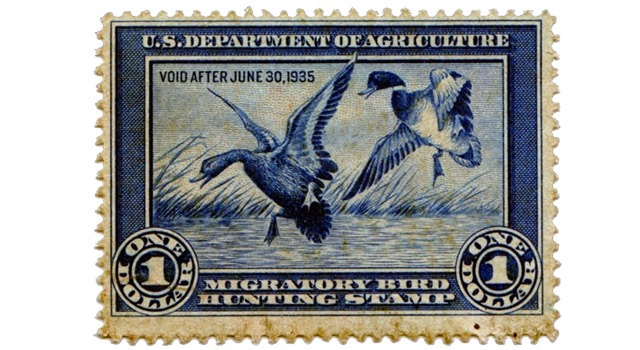In March 1934, when FDR signed the bill to create the Duck Stamp, there were probably few folks who realized how crucial Stamp funding would become over the next 80 years.
While the Migratory Bird Hunting and Conservation Stamp – as the Duck Stamp is officially called – is a functional Federal license for waterfowl hunters, it has become much more than that.
Almost immediately, the Stamp gave the relatively small and underutilized Migratory Bird Conservation Fund (MBCF) a real boost to protect riparian, wetland, and grassland habitat at a time when the Dust Bowl was devastating the American interior. The Stamp came just in time, helping secure NWRs in the Prairie Pothole Region and on the designated migratory flyways across the U.S.
Indeed, the Stamp has been responsible for collecting about $900 million since its inception, almost all of which has been deposited into the MBCF, gone to secure well over 5.5 million acres of National Wildlife Refuge System habitat.
Today, when reliable conservation funding for habitat protection is increasingly hard to come by, the Duck Stamp remains a dependable source. It’s something we can all count on, and by law – at least since 1958 – the dollars collected are secure and cannot be diverted to other purposes.
These investments are waterfowl-based, which in the Prairie Pothole Region include habitat for Mallard, Northern Pintail, Blue-winged Teal, Northern Shovelers, Gadwall, Canvasback, and Redhead. This is appropriate, but the investments certainly go beyond that.
Stamp dollars not only benefit waterfowl. Among scores of other bird species, numerous kinds of shorebirds, long-legged waders, and wetland and grassland songbirds are dependent on habitat derived from Stamp purchases. (Densities of grassland bird species such as Bobolink, Grasshopper Sparrow, Clay-colored Sparrow and Sedge Wren, are remarkably higher on Refuge System grasslands than on the landscape in general.)
You can say the same about that status of other wildlife – not only birds – benefiting from the use of the Stamp. Yes, reptiles, amphibians, fish, butterflies, all flourish through Stamp investments. Water quality is also strengthened.
For conservationists in the Prairie Pothole Region, the MBCF/Stamp investments are particularly important. Today, about 70 percent of this overall funding goes to secure wetland and grassland habitat in the Prairie Pothole Region. This is helping to secure the core of the continent’s “Duck Factory,” the major nesting grounds for our ducks. But these are also the same ducks that travel across the country and visit Stamp-secured habitat in stopover migration and wintering areas.
Relying on survey data provided by the Habitat and Population Evaluation Team (HAPET) offices in Bismarck, North Dakota, and Fergus Falls, Minnesota, the U.S. Fish and Wildlife Service identifies areas where the funds from the sale of the Stamps can acquire land and secure easements that best protect some of the most threatened and valuable wetland and grassland bird habitat in the country in the Dakotas, Minnesota, Iowa, and Montana.
We can also appreciate the grand tradition of remarkable artwork that graces the Stamp, a tradition which started in 1934. This is a vital connection between wildlife art and habitat conservation.
The Stamp has even spawned the wonderful Jr. Duck Stamp Program, which began with eight states participating in 1993 and has spread across the country, involving about 30,000 students yearly in “conservation through the arts.”
Does this mean that everything is ideal with the Migratory Bird Hunting and Conservation Stamp? Not really.
For starters, the Stamp Program is under-appreciated and not enough Stamps are sold. For example, sales of the 1971-1972 Stamp went over 2.4 million, the highest number ever sold. That was, however, when the U.S. population was only two-thirds of what it is today. And now, only about 1.4-1.6 million are sold. Today, the Stamp certainly needs wider appreciation leading to wider sales.
The cost of the individual Stamp has also not gone up since the 1991-1992 Stamp, rising from $12.50 to $15. What you may have bought for $15 in 1991 today costs about $25.70. The MBCF clearly needs to keep up with land-acquisition and easement costs.
The creation of an e-stamp is needed and probably inevitable. This is a good thing, but the traditions of the physical stamp – not the least of which is the art – also needs to be secure.
The creative Jr. Duck Stamp Program needs strengthening, continually encouraging the next generation of wildlife conservationists.
Finally, we could all benefit from better detailed tracking of who buys the Duck Stamp, including where and, especially, why.
In the meantime, the Stamp needs the support of all concerned Americans who value wildlife and wild places. If you are already in the habit of buying a Stamp, consider joining the organizations across the U.S. in a pledge to buy two Stamps a year!
Dollar for dollar, this is probably the most efficient and effective habitat conservation you can make!
To learn more about the Duck Stamp, contact Paul Baicich, President of the Friends of the Migratory Bird/Duck Stamp and PPJV Board Member.

